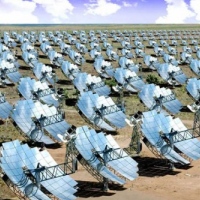Are Large Solar Projects in California Running out of Steam?

The Ivanpah Solar Electric Generating System, under construction in the California Mojave Desert near the Nevada border, will reportedly be the world’s largest solar energy project in the world when it is finished.
The plant’s 170,000 heliostat mirrors will focus the sun’s rays on tanks of water, producing steam to run a conventional turbine that produces electricity. Large-scale projects like this were once the focal point of solar’s future, attracting big investors, like Google, tax breaks from government and the ire of environmentalists who protested the disruption and destruction of fragile desert habitats.
That is changing. While solar is still a hot commodity, especially in California where state law compels utilities to get a third of their energy from renewable sources by 2020, there has been a decided shift from large projects to mid-size and small ones.
California’s boom in approval of large solar projects was short-lived. One project was approved in 2008, 10 in 2010 and one more in 2011, according to the California Energy Commission’s website on Large Solar Energy Projects. The site was last updated September 14, 2012.
Two of the approved projects were later withdrawn. The Beacon Solar Energy Project in Kern County was terminated August 27, 2013, after winning approval in 2010. Imperial Valley Solar (formerly called SES Solar Two Project) in Imperial County was terminated in 2011.
Five proposed projects never got approval. The Rio Mesa Solar Electric Generating Facility in Riverside County was terminated July 9, 2013. The Hidden Hills Solar Electric Generating System in Inyo County was suspended pending an April 3 review. The Ridgecrest Solar Power Project in Kern County is on hold. San Joaquin Solar 1& 2 bailed in 2010 and Carrizo Energy Solar Farm was terminated in 2009.
California’s experience mirrors the nation’s. The Los Angeles Times reported that 365 applications to develop solar plants were submitted to the federal government since 2009, but it looks like only 20 will be built. The first federal auction of public land—3,700 acres in Colorado—for development of solar failed to receive a single bid.
A 30% tax credit that helped fuel big-project construction is being reduced to 10% in 2016 and questions are being raised about how much renewable energy can be absorbed by the energy grid. Resistance from environmentalists and progress in developing a distributive system of energy involving residential consumers, businesses and midsize projects have made an impact.
Tight money, cheap natural gas and the vicissitudes of an energy marketplace still largely focused on fossil fuels have helped put a damper on a once-burgeoning, although briefly, large-scale solar industry.
But also in play are the utilities in California, which recognize renewable energy sources pose a threat to their business model. They have indicated that they are no longer projecting a need for more large-scale solar projects to make the state’s 33% requirement.
That was easy.
–Ken Broder
To Learn More:
After a Building Boom, Solar Energy's Prospects Now Aren't as Sunny (by Julie Cart, Los Angeles Times)
History of Solar Energy in California (Go Solar California)
California Solar Initiative Annual Program Assessment 2013 (California Public Utilities Commission) (pdf)
Feds Take Another Crack at Big Solar Projects (by Ken Broder, AllGov California)
- Top Stories
- Controversies
- Where is the Money Going?
- California and the Nation
- Appointments and Resignations
- Unusual News
- Latest News
- California Forbids U.S. Immigration Agents from Pretending to be Police
- California Lawmakers Urged to Strip “Self-Dealing” Tax Board of Its Duties
- Big Oil’s Grip on California
- Santa Cruz Police See Homeland Security Betrayal in Use of Gang Roundup as Cover for Immigration Raid
- Oil Companies Face Deadline to Stop Polluting California Groundwater





